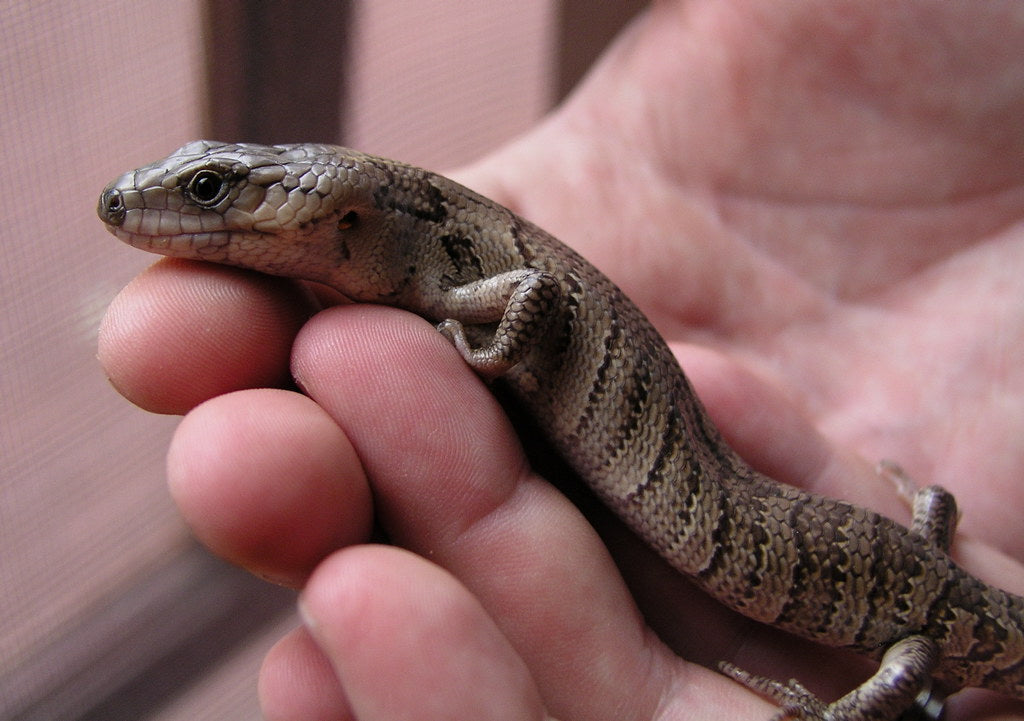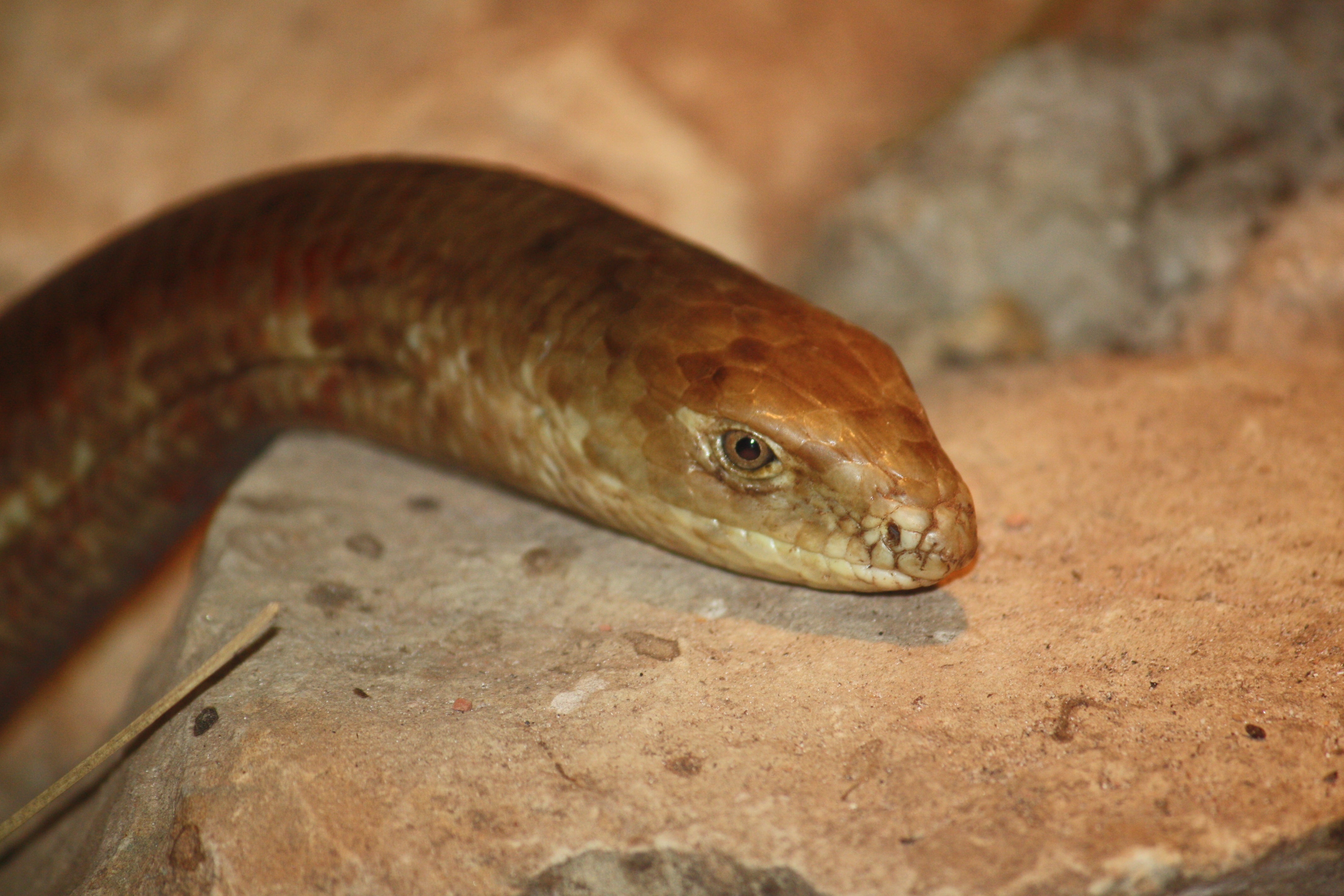Solomon Islands skinks (Corucia zebrata) are large, nocturnal, arboreal lizards native to Papua New Guinea and the Solomon Islands. They are found exclusively in primary tropical forest with dense foliage and mature trees, spending little to no time on the ground.
Solomon Islands skinks are typically 24-32” long, with a blunt square head, robust body, strong limbs, large claws, and a slender prehensile tail. Appearance is variable by population. Coloring can be light to dark green, beige to brown, or even yellowish. Pattern may be banded, spotted, mottled, or none at all. This species is also known as the prehensile-tailed skink or monkey-tailed skink.
Solomon Islands skinks are difficult-level pet reptiles due to their space, social, and dietary requirements, but they can be rewarding to keep for the dedicated pet owner. With good care, they are likely to live 10-15 years.
How much space do Solomon Islands skinks need?
Solomon Islands skinks are large, active lizards who need plenty of space for climbing and foraging. A single skink should be housed in absolutely no smaller than a 5’L x 3’W x 5’H terrarium, preferably larger. For housing multiple individuals, the enclosure size should be increased proportionally.
Cohabitation (keeping multiple Solomon Islands skinks together) tends to work well for this species, and some sources go so far as to recommend it for the animals’ psychological wellbeing.
Do Solomon Islands skinks need UVB?
Solomon Islands skinks do best when appropriate UVB lighting is provided in their environment. Lights should be on for 12 hours/day during summer and 8 hours/day during winter.
The best UVB bulbs for Solomon Islands skinks are:
- Arcadia T5 HO 6%
- Zoo Med T5 HO Reptisun 5.0
The UVB bulb should be housed in a reflective Arcadia or Vivarium Electronics fixture, roughly half the length of the enclosure, and placed close to the heat lamp. The basking branch or platform should be placed so the skink’s back is no closer than 12-14” below the lamp.
If you want to have live plants as part of the enclosure, such as pothos, you will also need a 6500K T5 HO fluorescent grow light to provide extra light in the enclosure. This also better simulates the effects of the sun!
What basking temperatures do Solomon Islands skinks need?
Solomon Islands skinks don’t bask unless ambient temperatures are uncomfortably chilly, but they should still have a temperature gradient with access to short-wave infrared for use as needed.
Provide a basking air temperature of 86°F, as measured by a digital probe thermometer with the probe placed on the basking surface. There should be a cooler area on the opposite side of the enclosure between 75-77°F.
Provide heat for your skink by imitating the sun with a cluster of at least two halogen heat lamps placed on one side of the enclosure. Do not use colored bulbs. The basking surface should be a sturdy branch. If you need help maintaining appropriate ambient temperatures, you can use a space heater in the room that the skink is in, or install a radiant heat panel controlled via thermostat.
Heating should be turned off at night, and temperatures can drop as low as 63°F.
What humidity levels do Solomon Islands skinks need?
Solomon Islands skinks need a high humidity environment for best health. Average humidity should be between 60-80%. You can monitor humidity levels with a digital probe hygrometer with the probe in the middle of the terrarium.
Misting your skink’s enclosure with a sprayer or automatic misting system every evening will help you create the right humidity levels. It also provides an important source of drinking water! More frequent misting and/or nightly fogging may be needed if you live in a particularly dry climate.
What substrate is good for Solomon Islands skinks?
Substrate covers the floor of your skink’s terrarium and helps make the enclosure more attractive, but it also helps maintain humidity. It’s ideal to use a substrate that imitates the “substrate” that the reptile naturally lives on in the wild. For Solomon Islands skinks, that means it should resemble tropical soil. It should have small particles and hold moisture well.
We recommend the following substrates for Solomon Islands skinks:
Substrate should be 2” deep and completely replaced every month, as this species produces a lot of waste. Remove poop and urates daily, along with contaminated substrate.
What décor can you use in a Solomon Islands skinks terrarium?
It’s terribly stressful for a lizard to be stuck in an enclosure with nothing in it except substrate and food/water bowls. It doesn’t matter how big the enclosure is if you don’t put things in it for your pet to use and interact with.
At bare minimum, you will need a branch for your skink to climb and bask on and some live or artificial foliage for it to hide in. However, it’s best to include other items, such as:
- large, sturdy branches
- thick vines
- cork hollows
- ledges
- textured bark background
- live, edible plants
All branches and other climbing materials should be well-secured against collapse.
What do Solomon Islands skinks eat?
Solomon Islands skinks are herbivorous, which means that they eat plants to get the nutrition that they need. These skinks should be able to eat their fill of greens every day, with vegetables and fruit offered every other day. Approximately 50% of their diet should be dark leafy greens, with 30% consisting of other vegetables. 15% can be fruit, and the remaining 5% can be treats. Chop vegetables into bite-sized portions to help prevent choking. Food should be offered in the evening rather than morning, since this species is nocturnal.
For a healthy, happy green Solomon Islands skink, offer as much dietary variety as you can!
Leafy greens for Solomon Islands skinks: mustard greens, kale, spinach, dandelion greens, hibiscus greens, cress, hawthorn, willow, fruit tree leaves (pesticide-free!), pothos
Other vegetables for Solomon Islands skinks: broccoli, rapini, zucchini, cauliflower, sweet potato, bell pepper, squash, carrots, okra, sprouts, pea pods, green beans, shredded carrots
Fruits for Solomon Islands skinks: berries, apple, pear, peach, plum, banana, mango, melon, papaya
Due to its high sugar content, fruit should be used as a treat. Edible flowers such as hibiscus and dandelion can also be offered. These should be collected from pesticide-free areas only.
Supplements
You will also need calcium and vitamin supplements to prevent your lizard from developing a deficiency. We recommend Repashy Calcium Plus Lod, dusted on food 2x/week for skinks less than 10 months old, and 1x/week for adults.
Water
Although Solomon Islands skinks get most of their water by lapping dew/raindrops from leaves, it’s still important to provide a bowl of fresh water. This bowl should be large, sturdy, and not easily tipped over. Ideally, it should also be located up off the ground.
Change out the water whenever it gets soiled, and give the bowl a good scrub with disinfectant once a week.
Do Solomon Islands skinks like to be handled?
Truthfully, few reptiles actually “like” to be handled. However, while Solomon Islands skinks do vary in temperament, they generally tame down well and seem to seek out and enjoy handling opportunities.
When you start handling your skink, be gentle. Don’t make rapid movements or grab the lizard from above, because that will make it afraid of you. Instead, approach from the side and scoop from below. Preferably the skink should come to you rather than you coming to it.
Support as much of its body as possible, especially its feet. Allow it to climb on you rather than restraining it. Handle inside the enclosure only at first, with very short handling sessions in the beginning, then gradually making them longer as your pet becomes more accustomed to you. Emphasize positive interactions, and treats can be used as an occasional bribe.
Solomon Islands skinks have powerful jaws and very sharp claws. They rarely intentionally inflict injury as long as you follow the above advice, but if you are worried about bites or scratches, wear a pair of thick leather gloves and a long-sleeved shirt for handling. Alternatively, if you just need to move the animal, use a branch rather than your hand/arm.
*This care sheet contains only very basic information. Although it’s a good introduction, please do further research with high-quality sources to obtain additional information on caring for this species.
"Solomon Islands Skink (Corucia zebrata)_5" by guppiecat is licensed under CC BY-NC-ND 2.0




Leave a comment
This site is protected by hCaptcha and the hCaptcha Privacy Policy and Terms of Service apply.